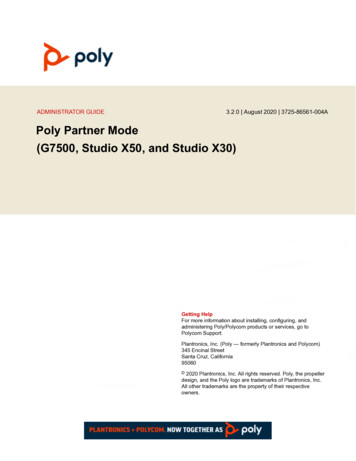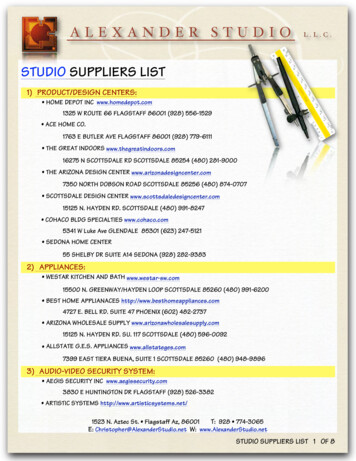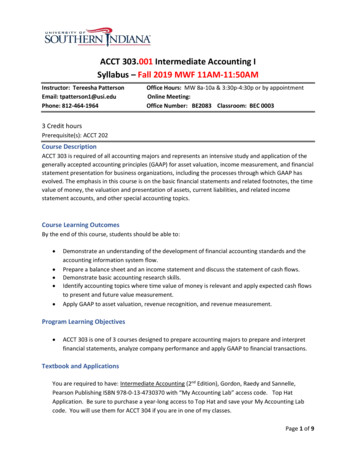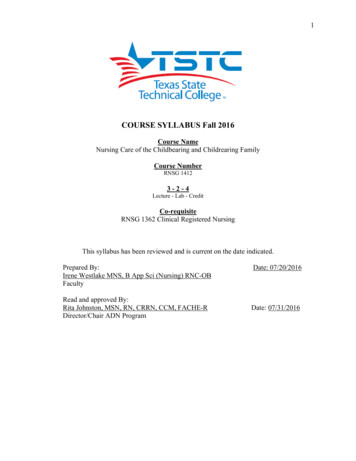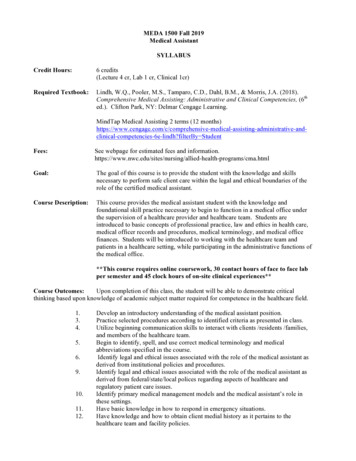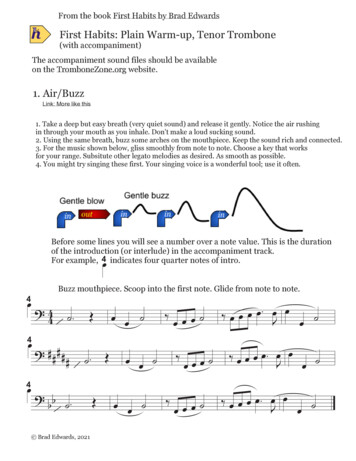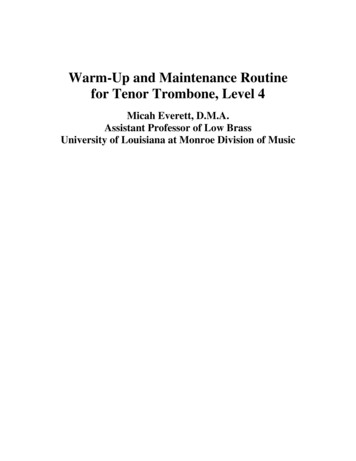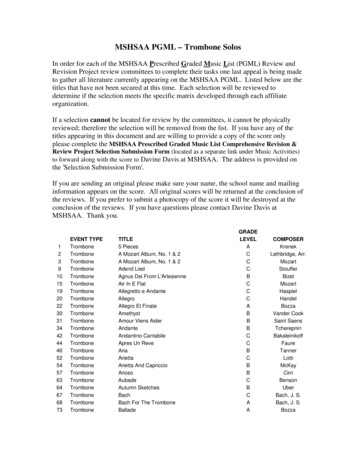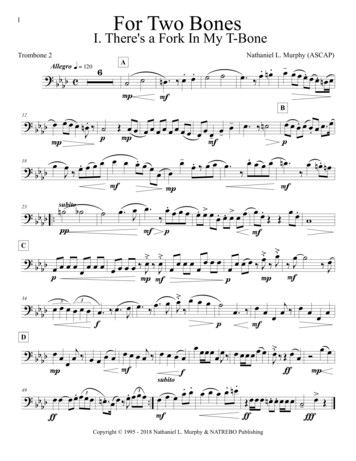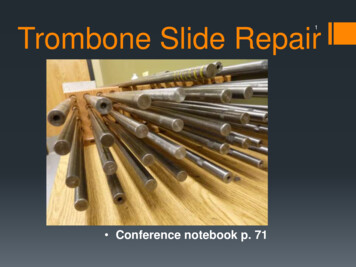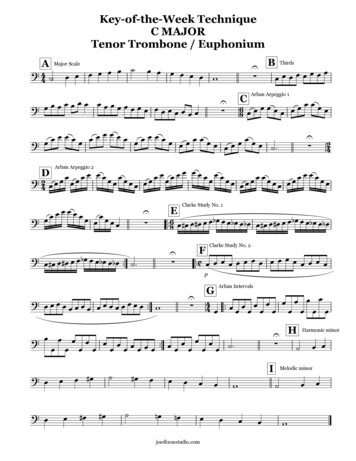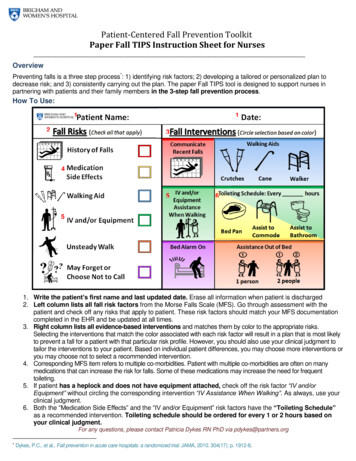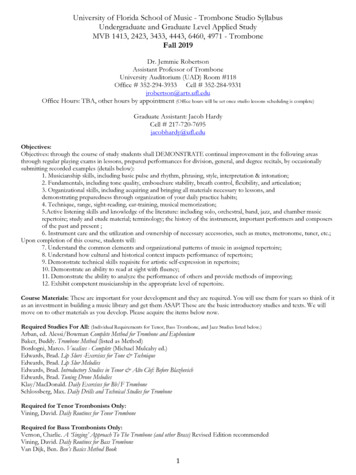
Transcription
University of Florida School of Music - Trombone Studio SyllabusUndergraduate and Graduate Level Applied StudyMVB 1413, 2423, 3433, 4443, 6460, 4971 - TromboneFall 2019Dr. Jemmie RobertsonAssistant Professor of TromboneUniversity Auditorium (UAD) Room #118Office # 352-294-3933 Cell # 352-284-9331jrobertson@arts.ufl.eduOffice Hours: TBA, other hours by appointment (Office hours will be set once studio lessons scheduling is complete)Graduate Assistant: Jacob HardyCell # s: through the course of study students shall DEMONSTRATE continual improvement in the following areasthrough regular playing exams in lessons, prepared performances for division, general, and degree recitals, by occasionallysubmitting recorded examples (details below):1. Musicianship skills, including basic pulse and rhythm, phrasing, style, interpretation & intonation;2. Fundamentals, including tone quality, embouchure stability, breath control, flexibility, and articulation;3. Organizational skills, including acquiring and bringing all materials necessary to lessons, anddemonstrating preparedness through organization of your daily practice habits;4. Technique, range, sight-reading, ear-training, musical memorization;5.Active listening skills and knowledge of the literature: including solo, orchestral, band, jazz, and chamber musicrepertoire; study and etude material; terminology; the history of the instrument, important performers and composersof the past and present ;6. Instrument care and the utilization and ownership of necessary accessories, such as mutes, metronome, tuner, etc.;Upon completion of this course, students will:7. Understand the common elements and organizational patterns of music in assigned repertoire;8. Understand how cultural and historical context impacts performance of repertoire;9. Demonstrate technical skills requisite for artistic self-expression in repertoire;10. Demonstrate an ability to read at sight with fluency;11. Demonstrate the ability to analyze the performance of others and provide methods of improving;12. Exhibit competent musicianship in the appropriate level of repertoire.Course Materials: These are important for your development and they are required. You will use them for years so think of itas an investment in building a music library and get them ASAP! These are the basic introductory studies and texts. We willmove on to other materials as you develop. Please acquire the items below now.Required Studies For All: (Individual Requirements for Tenor, Bass Trombone, and Jazz Studies listed below.)Arban, ed. Alessi/Bowman Complete Method for Trombone and EuphoniumBaker, Buddy. Trombone Method (listed as Method)Bordogni, Marco. Vocalises - Complete (Michael Mulcahy ed.)Edwards, Brad. Lip Slurs -Exercises for Tone & TechniqueEdwards, Brad. Lip Slur MelodiesEdwards, Brad. Introductory Studies in Tenor & Alto Clef: Before BlazhevichEdwards, Brad. Tuning Drone MelodiesKlay/MacDonald. Daily Exercises for Bb/F TromboneSchlossberg, Max. Daily Drills and Technical Studies for TromboneRequired for Tenor Trombonists Only:Vining, David. Daily Routines for Tenor TromboneRequired for Bass Trombonists Only:Vernon, Charlie. A ‘Singing’ Approach To The Trombone (and other Brass) Revised Edition recommendedVining, David. Daily Routines for Bass TromboneVan Dijk, Ben. Ben’s Basics Method Book1
Recommended for Jazz Improvisation and Style:Aebersold, Jamey. Play-a-longs (Various, There are over 100 volumes)Coker, Jerry. Patterns for JazzSnidero, Jim. Jazz Conception Play-a-long series (Progessive volumes: Easy, Intermdiate, etc.)McChesney, Bob. Doodle Studies and EtudesRecommended for Euphonium Doublers:Pilafian and Sheridan “The Brass Gym: A Comprehensive Daily Workout for Brass Players. Bass Clef Euphonium Edition.Payne “Euphonium Excerpts from the Standard Band and Orchestral Library”Required Texts for All:Ammer, Christine. The A to Z of Foreign Musical Terms by (From Adagio to Zierlich: A Dictionary for Performers and Students)Published by E.C. SchirmerJacobs, Arnold. (Compiled by Bruce Nelson): Also Sprach Arnold Jacobs: A Development Guide for Brass Wind MusiciansPublished by Polymnia PressRequired CD or Digital Soundfile for All: Sloane, Marcia. Cello Drones for Tuning and llo drones.phpAlso available via Spotify, iTunes, CDBaby etc Digital Subcription:Naxos Music Library: Streaming Music Service with free access for UF students. Listening assignments will be distributed viaplaylists. Instructions for Naxos Music Library and playlist access will be distributed separatelyAdditional Subscriptions: (Recommended only, not required, only Naxos is required. See above.)Spotify Premium Student Membership https://www.spotify.com/us/student/Students receive 50% discount off 9.99 monthly premium membership, thus it is 5 per month!Apple Music Membership3-Month Free Trialitunes.apple.com/ Then 9.99 per monthRecommended Apps and Software:iReal ProTE Tuner (Tonal Energy)Finale or Sibelius Music Notation SoftwareAdditional Strongly Recommended Materials:2000 LevelMarsteller Basic RoutinesRemington/Hunsberger The Remington Warm-Up StudiesDavis 15 Minute Warmup Routine with CD (A different and easier routine than below)Clarke-Gordon Technical StudiesEdwards Simply SingingVining Ear Training For TromboneStevens, Milt Scale and Arpeggio Routines:3000 LevelSnedecor Lyrical Etudes For TromboneBlazhevich Clef StudiesStevens (Milt) Scale and Arpeggio RoutinesGordon (Wycliffe) Sing It First4000 LevelDavis 20 Minute Warmup Routine with CD (Tenor Trombone/Euphonium) ORDavis 20 Minute Warmup Routine with CD (Tuba/BTRB same as above, 8vb) ORBlazhevich DuetsGraduate LevelBlazhevich SequencesBozza Etudes CapricesBitsch Rhythmical StudiesBoutry Etudes for High Perfection2
Required Materials and Supplies:Digital Audio and/or Video Recording Device (independent of your smart phone )Metronome (Or metronome app)Tuner (Or tuner app)Rotary or Piston Valve Oil (for F attachments)Slide "Stuff "(Slide-O-Mix, Trombotine, or some sort of slide cream)Tuning Slide GreaseA good case or gig bag for your instrumentMutes:Trombones: Straight, Cup, Plunger, Practice Mutes(Denis Wick or Jo-Ral are good brands)Euphonium: Straight Mute and Practice Mute (Denis Wick et al )Instrument Cleaning Materials (A “snake” and a mouthpiece brush)Instrument Quality: Is your instrument in great condition?If not, get it fixed up or INVEST in a high quality professional instrumentfor your college studies and beyond.Topical Outline:Each student shall meet with the instructor once per week and demonstrate preparedness and improvement at an arrangedlesson time. Lessons will begin on Monday, August 26th and the term will consist of weekly fifty-minute lessons.Trombone Choir will be held weekly on Mondays from 12:50-1:40 PM in MUB 121, Trombone Studio Class will be held onTuesdays at 10:40-11:30 AM (TBA), both are considered an extension of the private lesson. Attendance is required.Weekly Lesson Plan Outline:Each week demonstrate preparedness and improvement in the following areas (Specific weekly assignments, appropriate toyour level of study, will be administered in weekly lessons):Scales and Arpeggios (See Key of the Week Rotation)Lyrical Studies (Bordorgni/Rochut et al)Technical Studies (See new Key of the Week Rotation, Arban et al)Solo Work (Recital, Jury, or Competition Repertoire)Excerpt (Excerpt From Orchestral or Band Literature)orJazz Standard (Melody, Chord Changes, or Solo Transcription of Jazz Standard)Clef Study or DuetSight-readingTune of the Week/MonthSingle and Multiple TonguingSlur ExercisesLesson Content and Procedures (Taken from course proposal)Technical skill: Skill levels are assessed and techniques for improvement of deficiencies are demonstrated.Repertoire and/or exercises (scales, etudes, etc.) appropriate for the improvement of skills are assigned. Studentsdemonstrate their understanding of the techniques for improvement through its application to the repertoire and/orexercises assigned.Musicianship (Dynamics, Rhythm, Phrasing, Expression, Style): Exposure to repertoire and level ofmusicianship is assessed. Repertoire designed to fill deficiencies is assigned. Principles of musicianship appropriatefor the assigned repertoire are discussed and demonstrated. Students demonstrate their understanding of thoseprinciples through the application of the principle to repertoire performance.Sight Reading: Sight reading materials are chosen. Common elements and organizational patterns areidentified. Performance is attempted and analyzed with recommendations for improvement.Pedagogy: Principles of pedagogy and their application in appropriate settings are presented.3
Sample Level AppropriateProgression of SkillsFallSample Level AppropriateProgression of SkillsSpringStudent Must Demonstrate Proficiency inthese skill areas in order to progress tonext levels of studyStudent Must Demonstrate Proficiency inthese skill areas in order to progress to nextlevels of studyScales and Arpeggios-memorized00 Level - Major and Harm. Minor – 1 Octave14 Level - Major and Harm. Minor, 1 Octave,Chromatic Scales in Triplets, Quarter 8024 Level – All 2 Octave34 Level – All 2 Octave, Quarter 100-12044 Level – All 2 Octave, Quarter 120-16064 Level – All 3 Octave and Scales in ThirdsScales and Arpeggios-memorized00 Level – All 1 Octave, Quarter 8014 Level – Add Mel. And Nat. Minor, 1 Octave,Chromatic Scales in 16ths, Quarter 8024 Level – All 2 Octave, Quarter 8034 Level – All 2 Octave, Quarter 100-12044 Level – All 2 Octave, Quarter 120-16064 Level - All 3 Octave and Scales in ThirdsLyrical Etudes00 Level – Bordogni Vocalise 1-5, Concone14 Level – Bordogni 1-15, Fink24 Level – Bordogni 30-4534 Level – Bordogni 45-60, Snedecor I-X44 Level – Bordogni 45-9064 Level – Bordogni 60 – 120Lyrical Etudes00 Level – Bordogni Vocalise 6-10, Concone14 Level – Bordogni 15-30, Fink24 Level – Bordogni 30-4534 Level – Bordogni 45-60, Snedecor XI-XX44 Level – Bordogni 45-9064 Level – Bordogni 60 – 120Technical Etudes00 Level – Arban Introductory Studies14 Level – Arban Int. Studies and Art. & Style24 Level – Arban Characteristic Studies 1-634 Level – Tyrell 1-1044 Level – Bozza 1-564 Level – Bitsch and BoutryTechnical Etudes00 Level – Arban Introductory Studies14 Level – Arban Int. Studies and Art. & Style24 Level – Arban Characteristic Studies 6-1234 Level – Tyrell 10-2044 Level – Bozza 6-1064 Level – Bitsch and BoutryOther technique-Lip Slurs00 Level – Edwards Level A14 Level – Edwards Level A24 Level – Edwards Level C34 Level – Edwards All44 Level – Marsteller64 Level – MarstellerOther technique00 Level – Edwards Level A14 Level – Edwards Level B24 Level – Edwards Level D34 Level – Edwards All44 Level – Marsteller64 Level – Marsteller4
Sight Reading00 Level – Pederson Elementary14 Level – Lafosse Level A, Pederson El.24 Level – Lafosse Level B, Pederson El.34 Level – Lafosse Level C, Pederson Int.44 Level – Lafosse Level D, Pederson Adv.64 Level – Lafosse Level E-F, SlamaSight Reading00 Level – Pederson Elementary14 Level – Lafosse Level A, Pederson El.24 Level – Lafosse Level B, Pederson El.34 Level – Lafosse Level C, Pederson Int.44 Level – Lafosse Level D, Pederson Adv.64 Level – Lafosse Level E-F, Sauer, FinkSample Solo Repertoire Composers00 Level – Baker, Voxman, Clark14 Level – Guilmant, Barat, Cords24 Level – David, Rimsky-Korsakov,Marcello, Pryor, Sachse34 Level – Bozza, Pryor, Corelli, von Weber,Ropartz, Sulek,44 Level – Bourgeois, DeFaye, Casterede64 Level – Creston, Dutilleux, MartinSample Solo Repertoire Composers00 Level – Beach, Dearnley14 Level – Hindemith (3 Easy Pieces)24 Level – Hindemith (Sonata), Finger, GalliardI-IV, Saint-Saens, Davidson, Vaughan-Williams34 Level – Bozza, Pryor, Serocki, Blazhevich,Eccles, Guinguene44 Level – Chavez, Arnold, Persichetti, Berio64 Level – Goldstein, Serly, Hoddinot, Schuller5
Other requirementsMultiple Tonguing00 Level – Arban and Baker14 Level – Arban, Baker, Pilafian24 Level – Arban, Baker, Pilafian34 Level – Blazhevich, Kahila, Pichaurau44 Level – Blazhevich, Kahila, Pichaurau64 Level – Blazhevich, PedersonOther requirementsMultiple Tonguing00 Level – Arban and Baker14 Level – Arban, Baker, Pilafian24 Level – Arban, Baker, Pilafian34 Level – Blazhevich, Kahila, Pichaurau44 Level – Blazhevich, Kahila, Pichaurau64 Level – Blazhevich, PedersonClefs00 Level – Edwards Tenor14 Level – Edwards Tenor24 Level – Edwards Tenor and Alto34 Level – Edwards All, Blazhevich44 Level – Blazhevich, Fink, Sauer64 Level – Blazhevich, Fink, Sauer, PedersonClefs00 Level – Edwards Tenor14 Level – Edwards Tenor24 Level – Edwards Tenor and Alto34 Level – Edwards All, Blazhevich44 Level – Blazhevich, Fink, Sauer64 Level – Blazhevich, Fink, Sauer, PedersonOrchestral Excerpts00 Level – Rimsky-K. Russian Easter14 Level – Mozart Requiem Solo & Brahms I24 Level – Mahler 3, Wagner Lohengrin34 Level – Rossini La Gazza Ladra & W.T.44 Level – Berlioz Hungarian March et. al.64 Level – Ravel Bolero et. al.Orchestral Excerpts00 Level – Wagner Lohengrin & Tchaik. 414 Level – Milt Stevens Level A and B24 Level – The above Milt Stevens Level C34 Level – The above Milt Stevens Level D44 Level – The above Milt Stevens Level E64 Level – The above Level F and GJazz Standards and Improv00 Level – Playing by Ear14 Level – Green Dolphin Street24 Level – All the Things You Are34 Level – I’ll Remember April44 Level – Stella by Starlight64 Level – Don’t Get Around Much AnymoreJazz Standards00 Level – Playing by Ear14 Level – Body & Soul24 Level – Just Friends and Cherokee34 Level – What’s New & Over the Rainbow44 Level – Autumn Leaves64 Level – ‘Round MidnightOther Skills00 Level – Jaw Vibrato14 Level – Jaw Vibrato24 Level – Slide Vibrato34 Level – Doubling*44 Level – Doubling64 Level – Doubling*Doubling Guideline:Tenor Trombonists with F attachment addSmall Bore Trombone, Euphoni
Arban, ed. Alessi/Bowman Complete Method for Trombone and Euphonium Baker, Buddy. Trombone Method (listed as Method) Bordogni, Marco. Vocalises - Complete (Michael Mulcahy ed.) Edwards, Brad. Lip Slurs -Exercises for Tone & Technique Edwards, Brad. Lip Slur Melodies Edwards, Brad. Introductory Studies in Tenor & Alto Clef: Before Blazhevich Edwards, Brad. Tuning Drone Melodies
